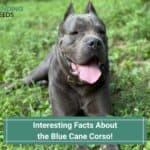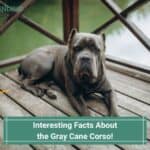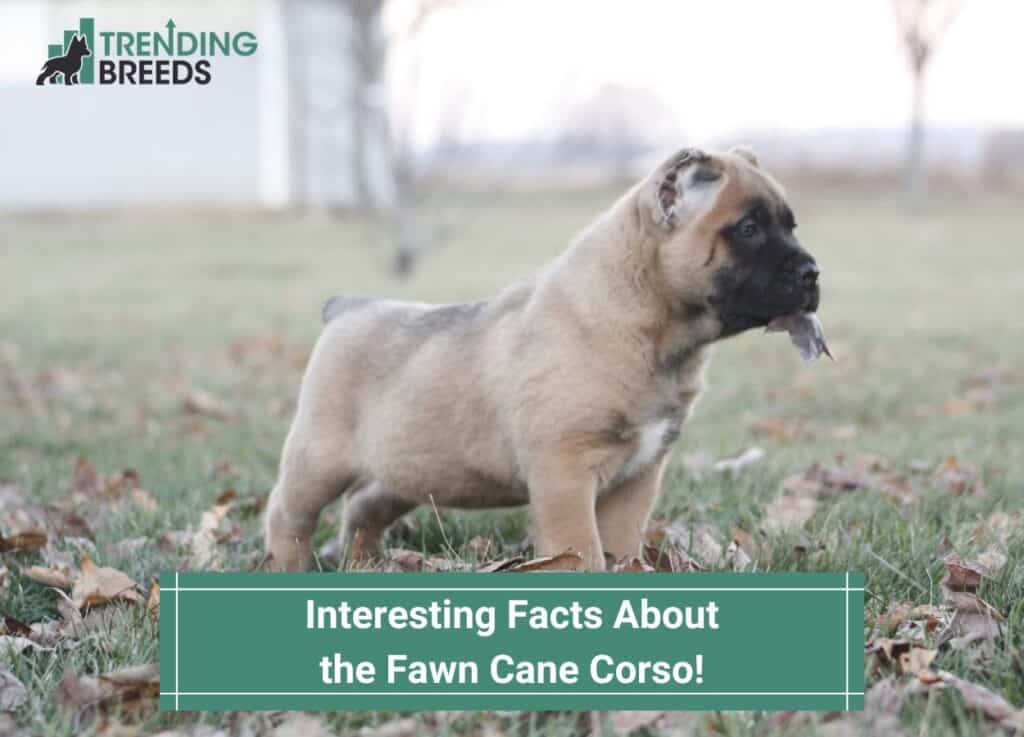
Cane Corso tends to have a bad reputation because of their massive size, as they can reach up to 27.5-inches tall from foot to the top of the shoulder and weigh more than 100 pounds.
In reality, they are very affectionate, loyal dogs who follow orders, so long as the owner can assert their dominance from the beginning.
Cane Corso can be assertive and headstrong, so anything less than a sturdy hand and unwavering sticktoitiveness could result in an unruly, undersocialized dog that can outweigh its owner by several pounds.
When raised correctly, these gorgeous, confident hounds are an invaluable addition to an experienced dog owner’s family. Besides that, they come in various stunning colors, including the fawn Cane Corso.
Other articles you would like: Have A Scaredy Cane Corso? Help Your Shy Dog and Can A Cane Corso Live Outside?
Table of Contents
What Is a Fawn Cane Corso?
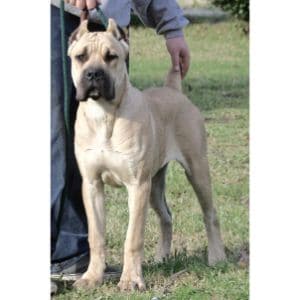
Fawn Cane Corso, also known as the Tan Cane Corso, is one of the most common breed coat variants. There is a lot of range in the shades, from honey blonde to a warmer light brown.
Some “unofficial” shades of fawn also exist, though they are signs of crossbreeding and, as such, do not qualify the Cane Corso as a true purebred. They also tend to have more health issues, including alopecia.
A few examples include the brown Cane Corso, who presents with liver or chocolate-colored coats but lacks the black mask. Isabella is almost lilac but has a pink nose, lips, and eyelids.
Staw Cane Corso are very similar to fawn but have black pigmentation on their backs and sides.
1. Fawn Cane Corso Has Been Around for Centuries
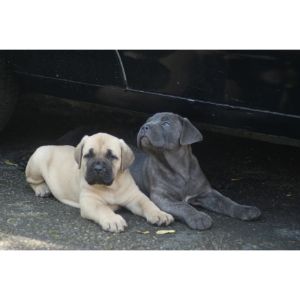
Cane Corso originated in Ancient Rome, along with their “brother” breed, the Neopolitan Mastiff. Both came from the Greek Molossian, a regal Mastiff that worked alongside Roman soldiers in war.
As the Roman empire fell, the Cane Corso as we know it today rose in prominence across Italy, where hunters and farmers particularly favored the fawn coloration.
The light color of their coats made them ideal for hiding out in the Italian forest, where the light slotting through the trees could camouflage their lighter coloration and help them be more stealthy when taking down prey of all sizes, including boar and bears.
On the homestead, the Cane Corso’s impressive size, protective temperament, and loving personalities made them adept as both protectors and companion animals.
2. Cane Corso Almost Went Extinct After WWII
During World War II, Cane Corso went to war again, which led to a severe shortage of the courageous breed. An overall decrease in the need for hunting and farming dogs also contributed to their near extinction in the 40s, 50s, and 60s.
In the 1970s, a Cane Corso advocacy group searched the countryside for remnants of the breed and worked to revitalize these majestic giants, an endeavor that proved successful.
By the 1980s, the first Cane Corso landed on American soil after a chance encounter between a Neopolitan Mastiff enthusiast who traveled to Sicily for a wedding and saw a farmer’s Cane Corso herding cattle.
The man stopped the chat with the owner and later imported the first of its kind to the United States.
3. The AKC Has Specific Rules for the Fawn Cane Corso Mask
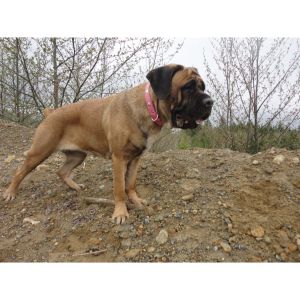
If you’re considering showing your fawn Cane Corso, make sure its facial mask meets breed standards.
It should be a dark, smoky black patch on the muzzle and around the inner part of the eye. If it goes past the eye, it is evidence of a non-purebred dog.
The only exception to this rule is in puppies, which can have a black saddle and black mask that covers a larger area than the AKC standards allow. Typically, they will fade as the pup ages, so long as they are purebred.
4. Rare Formentino Cane Corso Has a Dilute Fawn Gene
Formentino means “fermented wheat” in Italian, and it’s an apt description for this very light golden-tan Cane Corso coloration. Rather than a black mask, the formentino coat has a gray or blue mask and nose.
For a puppy to have formentino coloration, both parents must pass on the diluted fawn gene, which is a recessive trait.
Because dominant features “hide” recessive characteristics when they’re present, the color is only possible in a few special situations, which makes it so rare.
The best way to ensure a Formentino puppy in a litter is to crossbreed two Formentino parents. Then, only the dilute fawn gene is present, ensuring that all pups will have that coat color.
It’s also possible by crossing a Formentino with a fawn that has the dilute gene, but there is only a 25% chance for the recessive coat to appear.
Finally, some breeders will cross two fawn parents, each with a copy of the recessive dilute gene, netting a 50% chance of having Formentino pups in the litter.
5. Fawn Is Only One of Seven ‘Official’ Cane Corso Colors
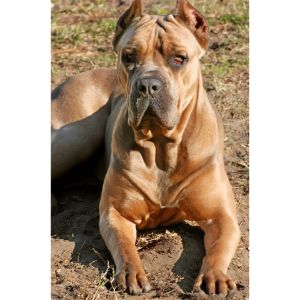
Cane Corso has strict breed standards when it comes to coat color in purebred dogs, and only seven of them make the cut for AKC registration:
- Black
- Fawn
- Gray
- Gray Brindle
- Red
- Black Brindle
- Chestnut Brindle
All of these coats are also allowed to have white markings, as long as they are limited to the chest, chin, throat, toes, or the back of the foot.
Gray brindle, black brindle, and chestnut brindle are particularly stunning, as they have multi-colored striped coats, all featuring some fawn pigmentation.
Gray brindle coats have a fawn base with black stripes, chestnut brindle coats are red with heavy fawn striping, and black brindles– the most common– are black with light fawn stripes.
However, black-and-tan Cane Corso is not recognized. It signifies that another breed, such as Doberman or Tibetan Mastiff, has introduced this particular coat color gene in past generations.
6. Tri-Colored Cane Corso Are a Fun Variation on Fawn
When a pup of this breed has a fawn coat, black mask, and white spots, they are considered a tri-colored Cane Corso.
It’s not uncommon for white markings to crop up in litters, and they add charming variety to a solid-colored Cane’s coat while still meeting AKC breed standards.
Red Cane Corso can also be tri-color, as they present with the black mask like the fawn-coated pups.
7. Fawn Cane Corso Are Perfect Guard Bodyguards and Cuddly Companions

There’s nothing that well-trained, well-socialized Cane Corso loves more than its family, and they are willing to put their imposing stature to work to protect them from danger.
Cane Corso is very vigilant and is known to monitor their homes by following their owner from room to room. They prefer to be wherever their family is to keep an eye on anything happening and intervene should things go wrong.
When all is well, these gentle giants are very loving and affectionate, so don’t be surprised when your Cane Corso tries to claim your lap with all 100+ pounds of its weight.
They are very sensitive to negative feedback because they want to please their owners and will pout or sulk if they feel they’ve disappointed you. A little love and plenty of pats should snap them right out of a cranky mood, though!
8. Grooming a Cane Corso’s Fawn Coat Is More Complicated Than It Looks
Don’t let the short length of the Cane Corso’s coat fool you. They’re double-layered, shedding their undercoat twice a year. That means they’re more prone to shedding than single-coat pups.
During most of the year, you can limit brushing to once a week, but in the springtime, when their shed is particularly heavy, you’ll need to do so daily.
Not only does this limit the amount of hair stuck to your clothes and couch cushions, but it also helps promote healthy new growth and helps your Cane Corso maintain a shiny coat.
With proper grooming, your Cane Corso should have short, stiff hair similar to bristles, with a softer, woolen undercoat that gets thicker in the winter.
9. Merle Cane Corso Are Not Purebred Dogs
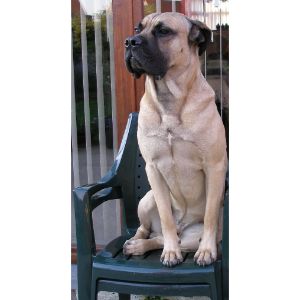
Because a merle gene doesn’t exist in the Cane Corso family line, any instances of this coat coloration are a sign that there has been some crossbreeding in past generations.
If a seller offers merle-coated dogs, the puppies will have fawn or gray coats with blue, red, or black splotches.
Even if you’re okay having a Cane Corso cross, merle coats may cost you a lot of money in vet bills. There is a correlation between this color and higher instances of hip dysplasia, outward-facing eyelids, and elbow dysplasia.
Always ask for any puppy’s papers and health records, especially those with unusual coats.
These can offer some information on other breed genetics in past generations and allow you to do your research on what medical issues those dogs may have introduced into the bloodline.
10. Cane Corso Coat Color Can Predict Their Lifespan
A 2017 study found some correlation between Cane Corso coat color and how long they live, with black brindle having the most extended average lifespan at 10.3 years and grey having the shortest at nine years.
Fawn Cane Corso falls right in the middle, at 9.01 years, shorter than brindle and grey brindle but longer than black.
11. Fawn Cane Corso Have Blue Eyes As Puppies
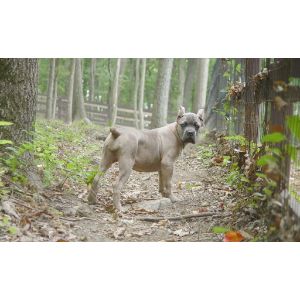
When they’re first born, fawn and Fermantino Cane Corso have stunning blue eyes that will darken to a rich brown as they age.
There has been controversy with breeders selling “rare” blue-eyed fawn pups at a higher cost, only for the new owner to find that their growing dog no longer has aqua-colored peepers.
Don’t be fooled by these scams, though. It’s perfectly natural.
Conclusion For “Interesting Facts About the Fawn Cane Corso!”
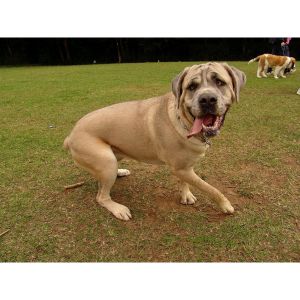
One of the best ways to promote acceptance of a breed is by taking the time to understand it, including all of its silly quirks and charming habits.
Hopefully, these 11 interesting facts about the fawn Cane Corso gave you some insight into the rich history of these pups and perhaps even made you consider owning one for yourself.
Fawn Cane Corso are beautiful, misunderstood dogs with barks much worse than their bite. Despite their poor reputation as aggressive and dangerous, they are very loving and will not lash out unless they feel that their family’s safety is at risk.
For the right owner, Cane Corso will dedicate their lives to staying by your side, doing any tasks you ask of it, and demonstrating unflappable dedication to their duty.
Before you start searching for sellers, though, do your research. Cane Corso requires experience and firm training, but your work will be rewarded with a loyal, intelligent, and playful companion.
You will also like:
- Is Your Cane Corso Too Skinny?
- Are Cane Corsos Naturally Protective?
- The Jaws And Bite Of A Cane Corso
For more information about the Cane Corso Breed, check out the video below:


